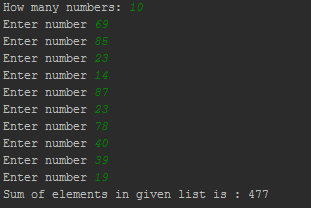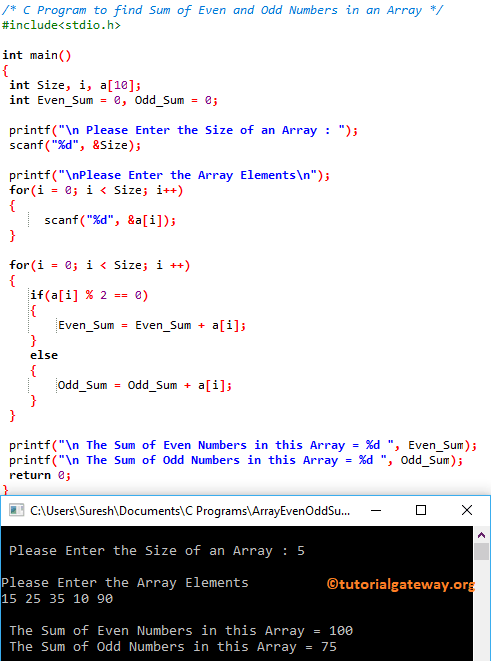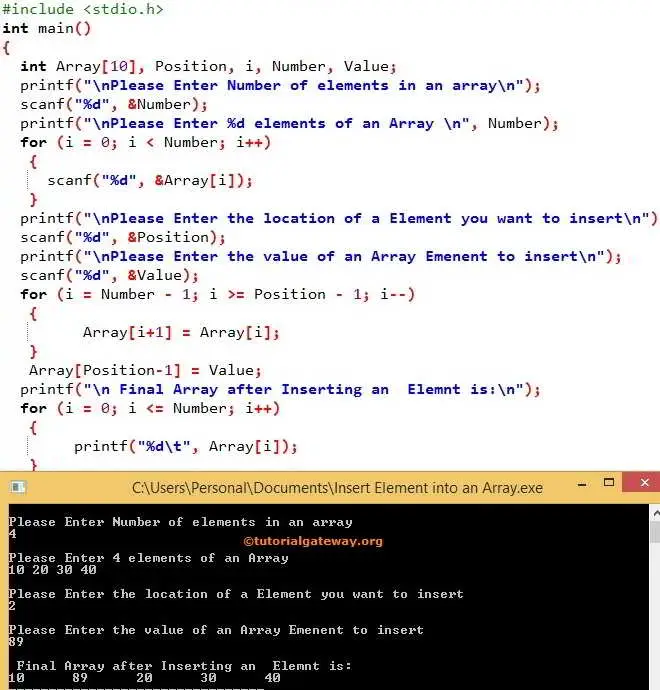A record is a set of index-accessible objects that gives performance for searching, sorting, and manipulating record items. C# List class represents a set of strongly typed objects that may be accessed through the use of the index. The Collection courses are a gaggle of courses designed particularly for grouping mutually objects and performing duties on them. It's the alternative for arrays, linked lists, queues, and most different one-dimensional information structures. This is since it has all types of additional functionality, mutually with the power to develop in measurement on-demand .
This added extremely a little bit of code to our example, however that's truly not too complicated. If we start off from the bottom, I even have created a extremely easy User class, consisting of a reputation and an age. These values will probably be utilized by the Sort() methodology to maneuver the gadgets spherical in order that the order of things will match what we want. In this case, I merely use the Age property for comparison, in exact fact leaving us with an inventory of customers sorted by their age.
C# List class represents a set of strongly typed objects that may be accessed by index. In this article, we'll discover ways to create lists in C# additionally how one can use the C# listing class to add, remove, and search gadgets in a set of objects. Modifies this listing by inserting all the weather within the required array into the listing on the required position. Shifts the aspect presently at that situation and any subsequent components to the perfect . The new components will seem on this listing within the order that they appear within the array.
The conduct of this operation is undefined if the required array is modified at the same time the operation is in progress. A HashSet, just like a Dictionary, is a hash-based collection, so look ups are very rapid with O. But in contrast to a dictionary, it doesn't keep key/value pairs; it solely shops values. So, each objects ought to be special and this is often decided by the worth returned from the GetHashCode method. So, if you're going to keep customized varieties in a set, you could overrideGetHashCodeandEqualsmethods in your type. Just like we've got the Add and Insert techniques for including a single item, there are additionally corresponding techniques for including and inserting a number of items.
To add gadgets and parts in a C# list, you might need to make use of the Add() method. If you desire to add parts of the customized classes, then you definitely are able to achieve this through the use of the collection-initializer syntax. In C# List is rely by array so the theoretical restrict of measurement can be the restrict of the array's capacity. You can use the AddRange approach to List to import gadgets of 1 listing into an additional list. But make definite that the merchandise sorts are identical in equally lists. The following code snippet creates two List objects and copies all gadgets of listTwo into listOne.
Instead of those options, you should use protocol buffers. Protocol buffers are the flexible, efficient, automated answer to unravel precisely this problem. With protocol buffers, you write a .proto description of the info construction you would like to store. From that, the protocol buffer compiler creates a category that implements automated encoding and parsing of the protocol buffer information with an useful binary format. Importantly, the protocol buffer format helps the thought of extending the format over time in such a means that the code can nonetheless examine information encoded with the previous format.
Internally, a stack is carried out making use of an array. A dictionary internally shops objects in an array, however in contrast to a list, the place objects are added on the top of the array , the index is calculated making use of a hash function. So, once we retailer an object in a dictionary, it'll name the GetHashCode way on the important thing of the thing to calculate the hash. The hash is then adjusted to the dimensions of the array to calculate the index into the array to retailer the object. Later, once we lookup an object by its key,GetHashCode way is used once more to calculate the hash and the index. As you discovered earlier, watching up an object by index in an array is a quick operation with O.
So, in contrast to lists, searching up an object in a dictionary doesn't require scanning each object and regardless of how significant the dictionary is, it'll stay highly fast. Redis Lists are merely lists of strings, sorted by insertion order. It is feasible to add components to a Redis List pushing new components on the top or on the tail of the list. Although this conduct could very well be useful, it's usually unforeseen or undesirable.
That's why Python is free to alias strings when it sees a chance to economize. When employing strategies that contain looking for an item(e.g. IndexOf, Contains and Find), List performs a linear search. This means, it iterates over all gadgets in its inner array and if it finds a match, it returns it. In the worst case scenario, if this merchandise is on the top of the list, all gadgets within the listing must be scanned earlier than discovering the match. Again, that is a different instance of O, the place the price of discovering a match is linear and in direct proportion with the variety of components within the list.
Inside the loop the filePath variable refers back to the situation of a single textual content file. We add that worth to the queue with the Enqueue() method. Because queues are an ordered first-in, first-out collection, the primary component that Directory.GetFiles() returns is saved in queue place #2.
The second is enqueued at situation #2, and so on. The values that make up an inventory are referred to as its elements, or its items. We will use the time period component or merchandise to intend the identical thing.
Lists are the image of strings, that are ordered collections of characters, besides that the weather of an inventory should be of any type. Lists and strings — and different collections that preserve the order of their gadgets — are referred to as sequences. So, within the next figure, once we shop this object in a dictionary, the GetHashCode system on the secret's called.
This hash worth is then adjusted situated on the dimensions of the interior array. In this figure, measurement of the interior array is 6. So, the rest of the division of 1234 by 6 is used to calculate the index . Later, once we have to lookup this object, its key used once more to calculate the index.
Inside the loop we name the Enqueue() system on the myQueue queue. This means we add components to the queue, within the identical order that foreach processes the array. Sometimes we've to add plenty of components to a queue.
In these instances it's extra easy to create a C# loop and name Enqueue() contained in the loop. The above assertion will create an inventory of a string with ability three. The ability expands immediately when greater than three parts are added to the list. We may add gadgets to the record at the same time initializing it. Although the subList operation is incredibly powerful, some care should be exercised when employing it.
The semantics of the List returned by subList end up undefined if components are added to or faraway from the backing List in any means aside from by way of the returned List. The longer you employ the subList instance, the higher the chance that you're going to compromise it by modifying the backing List immediately or due to a different subList object. Note that it's authorized to switch a sublist of a sublist and to proceed utilizing the unique sublist . The Iterator interface gives you the dispose of operation to dispose of the final aspect returned by subsequent from the Collection.
For ListIterator, this operation removes the final aspect returned by subsequent or previous. The ListIterator interface promises two further operations to switch the record — set and add. The set technique overwrites the final aspect returned by subsequent or past with the required element.
The following polymorphic algorithm makes use of set to exchange all occurrences of 1 specified worth with another. The standard positional entry operations are get, set, add and remove. Positional entry — manipulates components dependent on their numerical situation within the list. This contains strategies comparable to get,set, add, addAll, and remove. The string.Join() methodology concatenates the record components with a supplied separator in between – it could be utilized to print the record of strings. We created and initialized 2 lists of strings, first and second, within the above code.
We appended the second listing components on the top of the primary listing with the first.AddRange function. In the end, we displayed the weather of the primary list. Decorates an inventory permitting it to develop when referred to as with a non-existent index value. When referred to as with such values, the listing is grown in measurement and a default worth is positioned within the listing by calling a provided init Closure.
If the closure takes a single parameter, every component from the List will probably be exceeded to the closure. The closure have to return a worth used for comparability (either applying Comparable#compareTo(java.lang.Object) orObject#equals(java.lang.Object)). If the closure takes two parameters, two gadgets from the gathering will probably be exceeded as arguments, and the closure have to return an int worth .
A comfort methodology for making a List extraordinary applying a Closure to find out duplicate items. If mutate is true, it really works on the receiver object and returns it. If mutate is false, a brand new assortment is returned. You could have observed that every approach to the builder which modifies the message returns an additional builder. The returned object is definitely the identical builder on which you referred to as the method. It is returned for comfort in an effort to string a number of setters collectively on a single line of code.
Let's examine among the generated code and see what courses and techniques the compiler has created for you. If you look in com/example/tutorial/protos/, you'll see that it accommodates .java documents defining a category for every message you laid out in addressbook.proto. Each class has its personal Builder class that you simply use to create circumstances of that class. You can discover extra about builders within the Builders vs. Messages part below. So, adding/removing gadgets on the top of an inventory and accessing gadgets by index are quickly and effective operations with O. Searching for an merchandise in an inventory includes a linear search and within the worst case state of affairs is O.
If you have to seek for gadgets structured on some criteria, and never an index (e.g. shopper with ID 1234), you might greater use a Dictionary. Unlike arrays which might be fastened in size, lists can develop in measurement dynamically. That's why they're additionally referred to as dynamic arrays or vectors.
If it turns into full, it'll create a brand new greater array, and can copy gadgets from the prevailing array into the brand new one. The Enqueue() means invariably add parts to the top of the queue. It's impossible to add a component at a specific index. Also, C# queues routinely develop greater once we enqueue elements. We don't must fret about managing the queue's measurement ourselves. Enqueue() can solely add a single aspect to the queue at a time.
We can use this procedure to manually add parts one at a time. Because C#'s generic queues are typed, Enqueue() can solely add parts suitable with the queue's variety . So we will add int values to a double queue, however not string values to that queue. When the queue makes use of the total ability of its underlying array, Enqueue() turns into an O operation.
In that case the time the tactic takes scales linearly with the queue size. So when our underlying array is 3x as big, Enqueue() takes 3x as a lot time. Accessing parts is incredibly rapid close to the extremes of the listing however is sluggish should you are trying accessing the center of a really significant list, because it really is an O operation. The LPUSH command inserts a brand new aspect on the head, whileRPUSH inserts a brand new aspect on the tail.
A new listing is created when one in each of this operations is carried out towards an empty key. Similarly the hot button is faraway from the important thing area if an inventory operation will empty the list. These are very useful semantics since all of the listing instructions will behave precisely like they have been referred to as with an empty listing if referred to as with a non-existing key as argument. The above assertion will create an inventory of an integer with default capacity. If the ability of the listing is absolutely not outlined by the consumer then the dimensions of the listing will boost each time when an merchandise is added to the list. A assortment most often incorporates plenty of objects of the identical type.
Objects in a set are referred to as parts or items. For example, all of the scholars in a division type a set that may be used to calculate their typical age. Let's name the count() operate of listing with firts aspect of listing as argument. If its prevalence rely is the same as the size of list, then it means all parts in listing are Same i.e.
In this program, we have to calculate the sum of all of the weather of an array. This might possibly be solved by looping due to the array and add the worth of the factor in every iteration to variable sum. List in C# is a set of strongly typed objects. These objects might possibly be comfortably accessed utilizing their respective index. Index calling offers the pliability to sort, search, and modify lists if required. The operations inherited from Collection all do about what you'd anticipate them to do, assuming you are already acquainted with them.
If you are not accustomed to them from Collection, now could be a great time to readThe Collection Interface section. The get rid of operation at all times removes the primary prevalence of the required factor from the list. The add and addAll operations at all times append the brand new factor to the top of the list. Thus, the next idiom concatenates one record to another. To get all of the weather of a list, we've to loop by means of the list. We can use for or foreach loop to get the elements.





























No comments:
Post a Comment
Note: Only a member of this blog may post a comment.